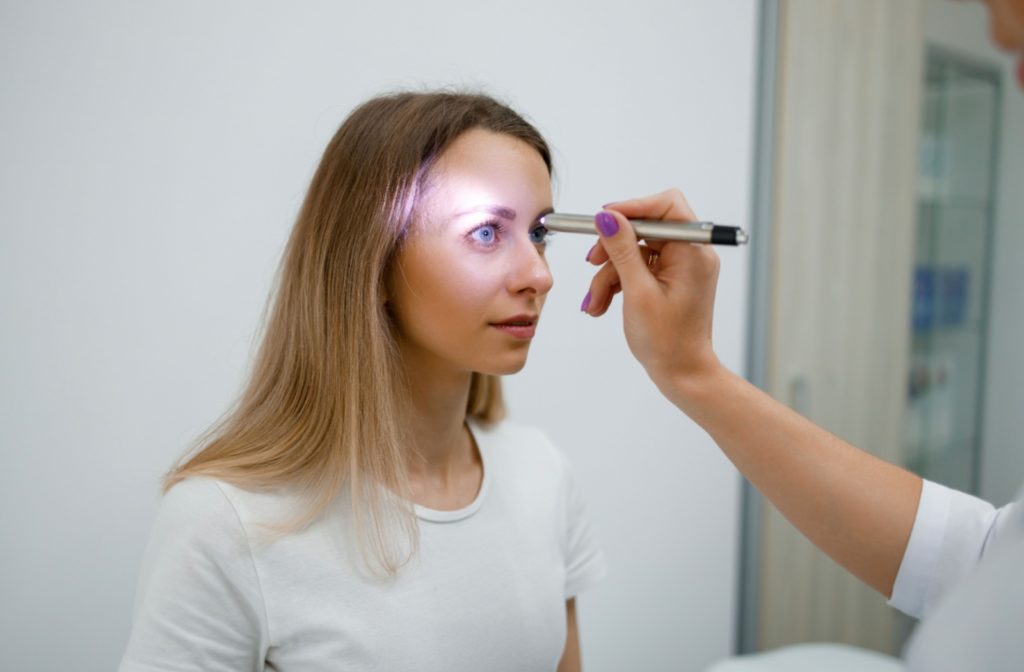How we see the vibrant colors of a sunset, the intricate details of a leaf, and the smile on a loved one’s face are all affected by the complicated dance of light in our eyes.
The eye’s cornea and lens are the two primary parts of the eye responsible for bending and focusing light onto the retina. How the eye focuses light determines how well we see.
Common refractive errors, such as nearsightedness or astigmatism, are caused by light passing abnormally through the eye. Fortunately, your eye doctor can help correct these refractive errors with prescription eyeglasses or contact lenses. Laser eye surgery may also offer a more permanent solution.
The Anatomy of the Eye
Understanding the eye’s anatomy helps explain how light travels through the eye. The human eye consists of several critical components:
- Cornea: The eye’s outermost layer that begins the process of focusing light
- Iris and pupil: The colored part of the eye (iris) regulates how much light enters and controls the size of the pupil
- Lens: This clear structure further fine-tunes the focus, directing light to the retina
- Retina: A layer at the back of the eye filled with photoreceptors that convert light into neural signals
- Optic nerve: Carries these signals to the brain, where they are interpreted as images
Each part of the eye plays a vital role in capturing and processing light, which allows us to see the world around us.
The Role of the Cornea & Lens
The cornea and lens work together to bend and focus light. First, light passes through the cornea, which provides most of the eye’s optical power. The light then moves through the aqueous humor, a clear fluid that nourishes the eye, before reaching the lens.
The lens fine-tunes the focus by adjusting its shape—a process known as accommodation—to focus the light rays onto the retina.
The Retina & Photoreceptors
Millions of photoreceptors are at the heart of the retina. These specialized cells detect light. They come in 2 main types:
- Rods: Responsible for vision in low-light conditions
- Cones: Enable color vision and operate best under bright light
When light photons hit these photoreceptors, they trigger chemical reactions that transform light into electrical signals. These signals are then relayed to the brain through the optic nerve.

Common Vision Problems
Refractive errors are vision problems directly related to how light passes through the eye. Understanding common refractive errors and associated symptoms can help individuals recognize vision issues early and seek appropriate corrective measures.
Myopia (Nearsightedness)
Myopia is a common refractive error where individuals can see close objects clearly but struggle with distant vision. People with myopia may squint to try seeing distant objects and have difficulty reading road signs or boards in classrooms. Sometimes, myopia can cause eye strain and headaches.
Hyperopia (Farsightedness)
Hyperopia is a refractive error where individuals can see distant objects more clearly than nearby objects. Those with hyperopia may have trouble reading and experience fatigue, headaches, or eye strain after focusing on nearby tasks.
Astigmatism
Astigmatism occurs when the cornea or lens of the eye has an irregular shape, causing blurred vision at all distances. People with astigmatism may experience blurred or distorted vision, eye strain, headaches, squinting to see clearly, and difficulties with night vision or glare sensitivity.
Presbyopia
Presbyopia is an age-related refractive error affecting near vision, usually occurring around the age of 40. This common refractive error is caused by the hardening of the lens in the eye, leading to difficulty focusing on close objects. People with presbyopia may find texts small or blurry, especially in low-light conditions. They may find themselves holding reading materials at arm’s length to try to see the words clearly.
Age-Related Macular Degeneration (AMD) & Cataracts
While AMD and cataracts are not actually refractive errors, they are both conditions that affect different parts of the eye, ultimately affecting how light enters the eye and your vision.
AMD is a progressive eye condition affecting the macula, the central part of the retina, leading to vision loss in the center of the visual field. Symptoms of AMD include blurred or distorted central vision, difficulty recognizing faces, straight lines appearing wavy, dark or empty areas in central vision, and a gradual loss of color vision.
Cataracts involve the clouding of the eye’s natural lens, leading to decreased vision quality. Common symptoms of cataracts include cloudy or blurry vision, sensitivity to glare, difficulty seeing at night, fading colors, double vision in one eye, and frequent changes in eyeglass prescription.
Talk to Your Eye Doctor About Your Symptoms
By understanding how light enters the eye, we can better appreciate the importance of eye health and take proactive steps to protect our vision.
While regular eye exams are still crucial to monitor your eye health, be sure to visit your optometrist as soon as possible if you notice any changes in your vision. Contact our team at Rancho Santa Margarita Optometry today to book an appointment. We’d be happy to help keep your eyes healthy.


